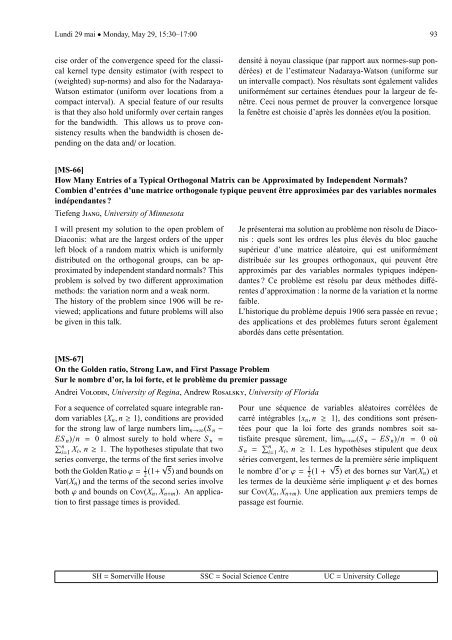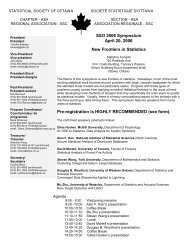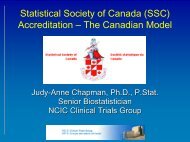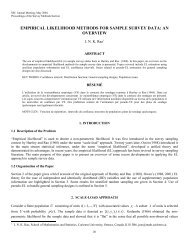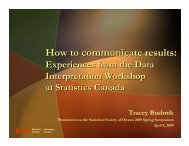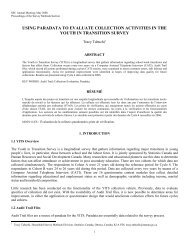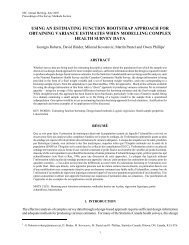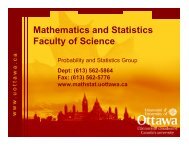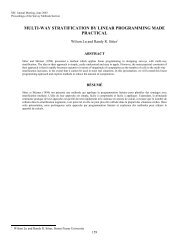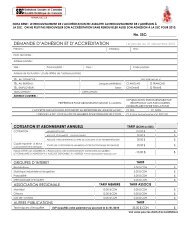Programme et résumés (pdf) - Société statistique du Canada
Programme et résumés (pdf) - Société statistique du Canada
Programme et résumés (pdf) - Société statistique du Canada
Create successful ePaper yourself
Turn your PDF publications into a flip-book with our unique Google optimized e-Paper software.
Lundi 29 mai • Monday, May 29, 15:30–17:00 93densité à noyau classique (par rapport aux normes-sup pon-dérées) <strong>et</strong> de l’estimateur Nadaraya-Watson (uniforme surun intervalle compact). Nos résultats sont également validesuniformément sur certaines éten<strong>du</strong>es pour la largeur de fe-nêtre. Ceci nous perm<strong>et</strong> de prouver la convergence lorsquela fenêtre est choisie d’après les données <strong>et</strong>/ou la position.cise order of the convergence speed for the classicalkernel type density estimator (with respect to(weighted) sup-norms) and also for the Nadaraya-Watson estimator (uniform over locations from acompact interval). A special feature of our resultsis that they also hold uniformly over certain rangesfor the bandwidth. This allows us to prove consistencyresults when the bandwidth is chosen dependingon the data and/ or location.[MS-66]How Many Entries of a Typical Orthogonal Matrix can be Approximated by Independent Normals?Combien d’entrées d’une matrice orthogonale typique peuvent être approximées par des variables normalesindépendantes ?Tiefeng JIANG, University of MinnesotaI will present my solution to the open problem ofDiaconis: what are the largest orders of the upperJe présenterai ma solution au problème non résolu de Diaconis: quels sont les ordres les plus élevés <strong>du</strong> bloc gaucheleft block of a random matrix which is uniformly supérieur d’une matrice aléatoire, qui est uniformémentdistributed on the orthogonal groups, can be ap- distribuée sur les groupes orthogonaux, qui peuvent êtreproximated by independent standard normals? This approximés par des variables normales typiques indépenproblemis solved by two different approximation dantes ? Ce problème est résolu par deux méthodes diffém<strong>et</strong>hods:the variation norm and a weak norm. rentes d’approximation : la norme de la variation <strong>et</strong> la normeThe history of the problem since 1906 will be re- faible.viewed; applications and future problems will also L’historique <strong>du</strong> problème depuis 1906 sera passée en revue ;be given in this talk.des applications <strong>et</strong> des problèmes futurs seront égalementabordés dans c<strong>et</strong>te présentation.[MS-67]On the Golden ratio, Strong Law, and First Passage ProblemSur le nombre d’or, la loi forte, <strong>et</strong> le problème <strong>du</strong> premier passageAndrei VOLODIN, University of Regina, Andrew ROSALSKY, University of FloridaFor a sequence of correlated square integrable randomvariables {X n , n ≥ 1}, conditions are provided carré intégrables {x n , n ≥ 1}, des conditions sont présen-Pour une séquence de variables aléatoires corrélées defor the strong law of large numbers lim n→∞ (S n − tées pour que la loi forte des grands nombres soit sa-ES n )/n = 0 almost surely to hold where S n = tisfaite presque sûrement, lim n→∞ (S n − ES n )/n = 0 où∑ ni=1X i , n ≥ 1. The hypotheses stipulate that two S n = ∑ ni=1X i , n ≥ 1. Les hypothèses stipulent que deuxseries converge, the terms of the first series involveboth the Golden Ratio ϕ = 1 2 (1+ √ 5) and bounds onVar(X n ) and the terms of the second series involveboth ϕ and bounds on Cov(X n , X n+m ). An applicationto first passage times is provided.séries convergent, les termes de la première série impliquentle nombre d’or ϕ = 1 2 (1 + √ 5) <strong>et</strong> des bornes sur Var(X n ) <strong>et</strong>les termes de la deuxième série impliquent ϕ <strong>et</strong> des bornessur Cov(X n , X n+m ). Une application aux premiers temps depassage est fournie.SH = Somerville House SSC = Social Science Centre UC = University College


